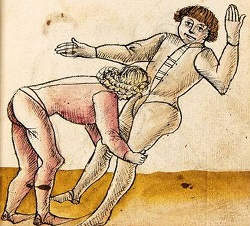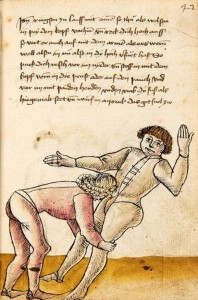 nderstanding how things work is essential in MA. We watch videos today, which is the learning aid of our time. In engineering, we call this utility film. In the future, we might also be able to use augmented reality. Historically, however, we used the method of “picture + descriptive text” to describe instructions for lines of action – like in grappling, fencing, etc. This worked well for centuries. And it still does. The picture in such a description most often shows only one snapshot within a polymorphic action. So, by looking at the picture, you might get an idea what to do, but without the descriptive text you will never be able to understand – and to know for sure – what the intended action was meant to be: Where does it start, where does it end, and what exactly is done in between?
nderstanding how things work is essential in MA. We watch videos today, which is the learning aid of our time. In engineering, we call this utility film. In the future, we might also be able to use augmented reality. Historically, however, we used the method of “picture + descriptive text” to describe instructions for lines of action – like in grappling, fencing, etc. This worked well for centuries. And it still does. The picture in such a description most often shows only one snapshot within a polymorphic action. So, by looking at the picture, you might get an idea what to do, but without the descriptive text you will never be able to understand – and to know for sure – what the intended action was meant to be: Where does it start, where does it end, and what exactly is done in between?

A polymorphic action as depicted and described in the Wallerstein Codex. (Picture credit: “Wiktenauer” Facebook page)
Furthermore you would need to not only understand the language the text is written in, but also be experienced in the practical application of the specific field in question. In this case, I’d like to take a look at a short polymorphic action – or a combo or drill if you like – I translated both in language as well as in practical implementation from the German fencing Codex I.6.4º.2, from the year AD 1556.
When you visualize the technique, you would most probably come up with something like morote-gari as found in Kodokan Judo:

Morote-gari as found in Kodokan Judo.
Now add the following written description from the 1556 original, take a partner and re-enact it.
First, the instruction says that both parties are already engaged. Then it tells the left person to seize the head of his opponent (right):
1) When you grapple closely, try to grab his head with your arms.
Next, if the right person escapes this attempt, the left person achieved to create a ‘favorable tactical situation’, which he then applies like this:
2) If he wards this off and stretches himself up and backwards to prevent being grapped at the head, then quickly bend down and ram your head against his chest or his abdomen, and thereby lay hold of both his legs with both your hands – as is shown in the drawing – and simultaneously ram your head in and pull his legs back with your arms: in this way he falls on his back.
Finally, the instruction tells the left person what to do, if he would be the one being attacked that way: In practical application you now place yourself in the position of the right person.
3) When you are being attacked in this way, wait for him to bend forward, and in the moment he tries to ram his head into your chest or stomach, smash your knee under his chin.
From the above description it becomes clear that the “technique” is actually a complex action. Just like we can rebuilt Da Vinci’s machines, with the knowledge of language and practical experience it is possible to decode and re-enact each and any of the fighting pieces we inherited from our ancestors. And there are thousands of it, recorded during the height of this art.

A polymorphic action as depicted and described in the Wallerstein Codex. (Picture credit: “Wiktenauer” Facebook page)
© 2015, Andreas Quast. All rights reserved.
